Flex Basketball Offense - A Comprehensive Guide
The Flex Offense is a very effective offense that is based on a continuity pattern. By incorporating modern offensive concepts, you can make this look like a Flex Offense with motion offense principles.
Here are 7 Benefits of the Flex Offense
- Accelerates player development: All 5 players get to play all 5 spots. This means every player plays inside and out, accelerating player development.
- Causes defensive mistakes: There is constant player movement and ball movement which leads to more defensive mistakes.
- Great spacing: You always have good spacing which leads to more dribble attack lanes and passing lanes.
- Counter for every defensive coverage: It doesn't matter if the defense is switching, denying, trailing, etc. The flex offense has a counter.
- Great rebounding: You have good offensive rebounding and transition defensive positioning.
- Creates mismatches: It's hard for the defense to defend all of the screens which often leads to mismatches. It works even better if the opposition switches most screens.
- Adaptable and fluid: Many think the flex offense is just a patterned offense, but you are only limited by your imagination when it comes to how you run it.
I ran the flex as a change-of-pace offense throughout my coaching career. It continually amazed me that even when teams knew what was coming, we would almost always get 1-2 layups a game by running it.
The Flex Offense is also very popular at the college and NBA levels. In the last few years, the Bulls, Hawks, Jazz, Magic, and Heat all ran variations of the flex offense. At the college level, Auburn has run it, and Maryland and Gonzaga have popularized the flex offense. Each team has a unique way to run the offense, and so can you.
If you're looking for creative ways to use the flex for your team, check out The Hybrid Flex Offense With Don Kelbick.
You can view the diagrams and video of the flex offense below.
Contents
- Flex Offense Overview
- Flex Offense versus Zone
- Flex Offense Basketball Plays
- Flex Offense Basketball Drills
- Flex Offense For Youth Basketball Teams
To get FREE 33 Winning Basketball Plays, click the banner below
Flex Offense Overview
Basic Flex Motion - Guard to Guard Passes
When a guard-to-guard pass is made, the player on the low block sets a flex screen for the player in the corner, which is followed by a down screen by the passer for the player setting the flex screen.
Any time this guard-to-guard pass is made, this action occurs. You could run the flex offense simply by passing guard to guard continuously. You will see this action over the next few diagrams.
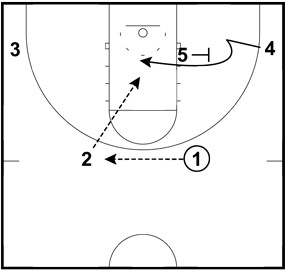
Steps:
1 passes to 2.
5 sets a flex screen for 4. 4 cuts across the lane looking for the pass from 2. This is the first option off of the flex. If 4 does not receive the pass, 4 finishes the cut at the low block.
After the screen is set, 5 opens up to the ball. This is the second flex offense option.
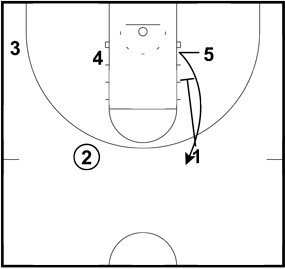
1 sets a down screen for 5.

1 clears to the corner.
2 passes to 5.
4 sets a flex screen for 3.

2 sets a down screen for 4.
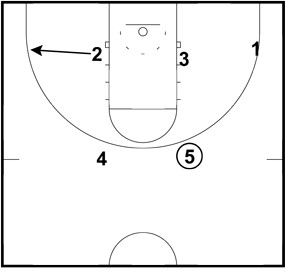
2 clears to the corner.
And the flex pattern continues.
The flex cut is the key to the offense. Run correctly, it's extremely difficult to defend and will result in layups for your team.
Flex Offense - Corner Pass Option
Within the flex motion, whenever a pass is made to the corner, the passer sets a down screen for the opposite wing. With proper timing, this flex action will often turn into a double-staggered screen as you will see in the diagrams below.
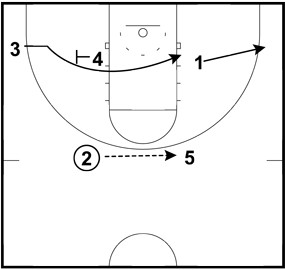
1 clears to the corner and 2 passes to 5.
4 sets a flex screen for 3.
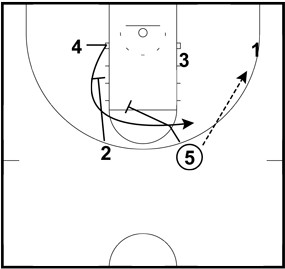
2 sets a down screen for 4 and 5 passes to the 1 in the corner.
5 sets a screen for 4. This turns into a double-staggered screen for 4.

2 clears to the corner. 1 passes to 4. 4 passes to 5.
3 sets a flex screen for 1.
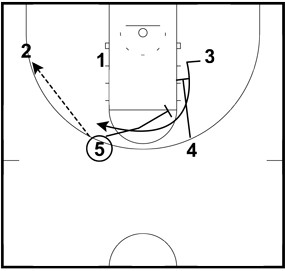
4 sets a down screen for 3 and 5 passes to 2.
5 sets a screen for 3.
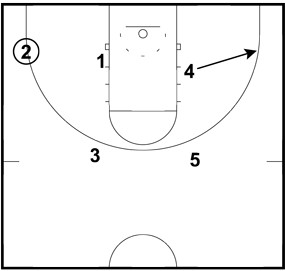
4 clears to the corner, and the flex offense pattern continues.
Many coaches are concerned about what to do when defenses switch.
Flex Offense V Zone
The flex offense was designed to attack man-to-man defenses. As a result, most coaches that run flex use a different offense when facing zones. The obvious disadvantage to this approach is that you now have two separate offenses to teach.
Even though flex is designed for man defenses, many coaches have had success using the flex against zone by making a few adjustments.
Here is the most common method that I see coaches use to attack the zone using the flex offense. It is simple and effective.
Flex Zone Offense
The pattern is very simple. You adjust the flex pattern by eliminating the down screen.
You now have two guards on top and three players low. You only rotate the three players down low against the zone. The top two players work together, and the bottom three players work together by setting flex screens on the ball reversal.
Here is the basic pattern:
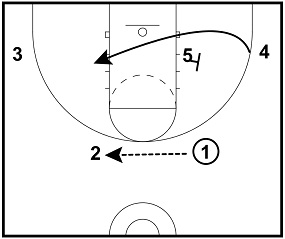
1 passes to 2.
5 screens/seals the defender responsible for the middle of the zone.
4 cuts to the block.

2 looks inside.
5 pops out to the corner.
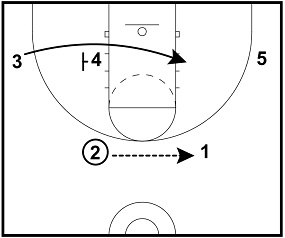
2 passes to 1.
4 screens the middle zone defender.
3 cuts to the block.
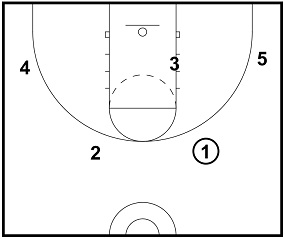
Players are in flex spots and the pattern continues.
The Bottom Players
When playing against a zone, you may need your baseline players off the baseline (around the mid-post). This will help with spacing and passing angles. However, you should experiment and be aware of their positioning.
The key is to teach your bottom three players how to play together. If they run the pattern robotically, you'll be in trouble.
Your screener needs to screen the middle of the zone.
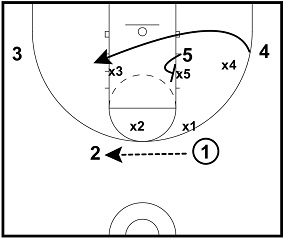
In this diagram, you can see the positioning of a standard 2-3 zone defense.
On the ball reversal, X5 will be responsible to cover 4 cutting to the strong-side block. So 5 needs to spin and box/seal X5, giving 4 an opportunity to get open.

If 5 is able to set a good screen, you can see that X3 has a choice. He/she can either guard 4 on the block or 3 in the corner.
2 can pass to 3 in the corner for the open shot, 4 on the block, or hit 5 sealing on the backside.
With this basic pattern, you get constant overloads and simple movement with your bottom players to get the ball inside.
This by itself can work. You'll get shots in the corner, ball reversals, and looks inside. However, your effectiveness will be limited unless you teach zone offense principles.
The bottom players should be encouraged to box and seal players to create opportunities. These opportunities can be present before or after the screen. They can also be on either side of the basket. You'll notice that depending on how X4 and X5 react, there could be an opportunity for a seal on the weak side.
Post players should also look to just "play basketball" and follow basic zone offense principles. They should look to seal and post up. The cutter should look to flash in the gaps. The screener should also look to flash in the gaps and then go back to their spot if nothing is there.
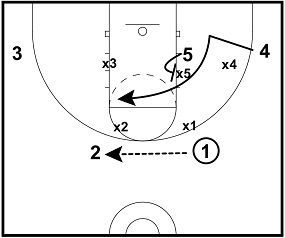
In the diagram to the right, you see an example of the high post flash. Instead of cutting the block, the flex cutter can look to cut to the high post area. The screener could also look to cut to the high post.
Again, they just need to play basketball. Maintain spacing and look for openings.
To be effective, you should get the ball inside via drive and/or pass. You don't have to score every time you go inside. Bring the ball back out, make the defense recover, look for an easy shot, and keep running the offense. Any time you make the offense move and adjust, you are distorting the zone and exploiting weaknesses.
Corner Option
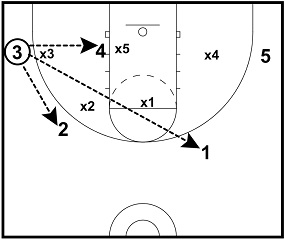
With the ball in the corner, X3 is drawn out, and the player on the block will have a one-on-one post-up opportunity. 4 should seal for position and post up. 3 can shoot the ball, pass to 4, or hit 1 on the skip pass.
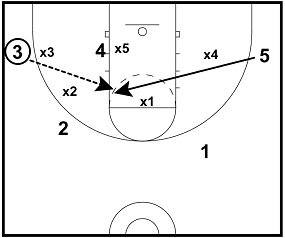
You can optionally allow 5 to cut to the high post/middle when they see an opening. If nothing is there, 5 should move back to their spot to resume the pattern.
Top Players
When facing a 2-3 zone, the biggest challenge for the top players is to deal with pressure from X1 and X2. You'll want your best ball handlers on top that are comfortable with potential pressure.
In theory, players 1 and 2 could stay in the same spots and simply shoot, drive, or pass. However, we all know that the defense will try to take that away, and things won't be that easy.
Your players on top should look for ball reversals, look inside, find open spots, use their dribble, penetrate, and just play basketball.
The shallow cut is a simple way for the top two players to get movement.
Pressure Release
You can use the shallow cut when the top player is getting denied and you need a pressure release.
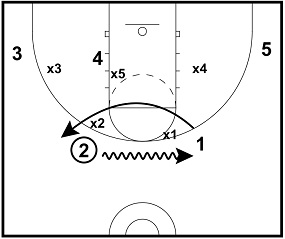
Shallow Cut When Ball is on the Wing
If the ball is on the wing and the ball reversal is denied, 2 can dribble at 1. This signals 1 to run a shallow cut and exchange positions.

Shallow cut when the ball goes to the corner.
If the ball is on the corner and the pass back to the wing is denied, 2 can run a shallow cut. This will pull X2 toward the basket and open up the passing lane while 1 fills the open spot.
This should allow for a quick ball reversal to 2 and continuation of the pattern.
Use Basic Zone Offense Principles
As with any offense, there are principles you need to follow to make it work:
- Maintain excellent spacing.
- Teach players fundamentals: shooting, sealing inside, posting up, passing, dribbling, etc.
- Use pass fakes to move the zone.
- Get the ball inside via post passes and dribble drive.
- Use ball reversals to shift the zone.
The key to zone offense is to "disrupt zone responsibilities". In a zone, each player is responsible for guarding an area. If you can momentarily force a defender to be in a position so they can't guard "their area," you have a chance to exploit the zone. This is the zone's biggest weakness and why you should actually like playing against zones.
You know ahead of time where the defenders will be and which area they are responsible for. So now you can exploit those responsibilities via screening, cutting, player movement, and ball movement.
Adjustments Against 1-3-1 Zone
This pattern is usually more effective against an odd-front zone like a 1-3-1 zone. The only adjustment you need to make is to teach your screener who to screen (the defender responsible for covering the strong-side block). Determine who is responsible for covering that area and screen them.
Variation: Designated Flex Cutter
A variation to this pattern is to use a designated flex cutter. Have one flex cutter (rover) and the other two posts constantly screen the zone and open to the ball. The cutter should look to flash to gaps rather than run traditional cuts.
Just Use Spots
One of the simplest ways to beat a zone is to just put players in the gaps of the zone and play basketball. If it's a 2-3 zone, use a 1-3-1 set and play ball. If it's a 1-3-1 zone, use a 2-3 set and play basketball.
The key to any zone offense is following basic zone principles. In reality, it doesn't matter what you run if you have skilled players that follow zone principles.
Flex Offense Basketball Plays
These 3 flex plays will get you a number of different scoring opportunities attacking the basket via UCLA screens, rub screens, and ball screens. And if the defense collapses, you will get wide open jump shots due to the great spacing.
The 1-4 high is a very flexible entry that you can run a number of ways. You can run quick hitters from the 1-4 and/or use it to initiate your flex offense.
Take a look at three different flex plays from the 1-4 high set below...
Flex Play #1 - Pass To Wing
Here is a video clip of the pass to wing option from Don Kelbick's Hybrid Flex Offense.
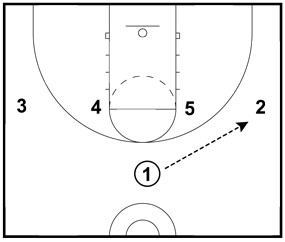
The point guard can pass to any player. In this example, the point guard passes to the wing.
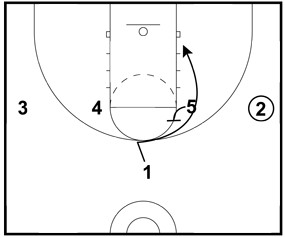
The player on the strong side elbow (player 5), sets a UCLA screen for 1.
2 looks for player 1 cutting to the basket.

5 and 4 pop to a wing. 3 drops to the corner.
Players are now in their flex spots.
If 1 isn't open, 2 can pass to 5. 5 can make a guard-to-guard pass to 4 and the flex offense has been initiated. (Note: if 4 is covered, he/she can screen away, which is the pressure release for the basic flex offense.)
Flex Play #2 - Pass To Post

In this example, the point guard passes to a post player (on the elbow).
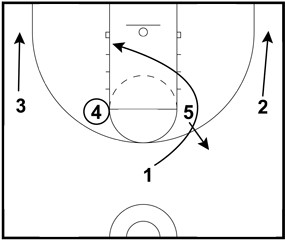
After the pass, 1 rubs off the weakside post and goes to the block.
4 looks for 1 cutting to the block.
3 and 2 drop to the corners and 5 pops out (into their flex spots).
Players are now in their spots and can go right into flex.
Flex Play #3 - Strong Side Ball Screen Option
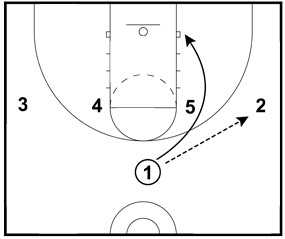
Here's how you can run the strong side ball screen option from the 1-4 high entry:
1 passes to 2.
1 runs the UCLA cut.

5 sets a ball screen. 2 uses the ball screen and attacks.
3 cuts to the corner. 4 cuts to the wing.
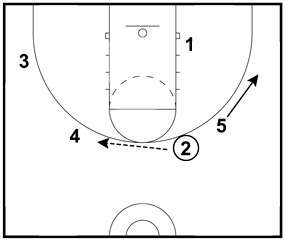
2 can look to score or pass to 4.
5 cuts to the corner, and players are now in their flex spots and can immediately start the base flex offense.
If you want to start in a flex alignment and transition to a ball screen with some misdirection, try this play:
Flex Play #4 - Strong Side Ball Screen Option
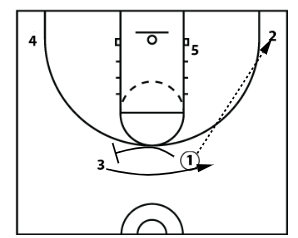
1 passes to 2 in the corner.
1 screens away for 3.
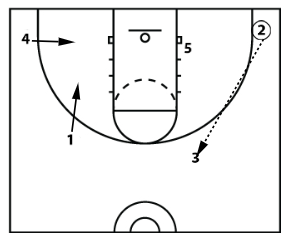
2 passes to 3.
1 & 4 move into screening position on the weak side.

5 comes up and sets a ball screen for 3. 5 rolls.
2 runs off a double screen from 4 & 1.

If 3 can't score or pass to 5, they should look to 2 on the wing for a 3.
1, 4 & 5 all pop out to the perimeter.

If no scoring opportunities are open, you are back into flex spacing.
To learn more of Coach Kelbick's flex entries, check out The Hybrid Flex Offense With Don Kelbick.
For those who are fans of college basketball, here are a couple other flex actions we've seen:
3 Flex Offense Basketball Drills
Flex Drill #1 - Screen The Screen Shooting Drill
This flex drill isolates and simulates the "screen the screener" action, which occurs after the flex screen. The drill improves players' footwork and ability to knock down shots coming off the screen. This is how you can work on this skill with a large group of players at a basket.
No matter what offense you run, it's very important that you break down your offense into drills like this in order to get game-like shots.
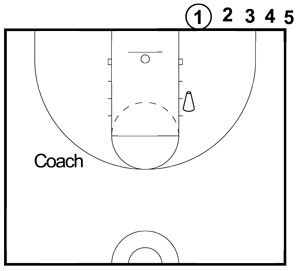
Players line up near the baseline. Each player has a ball. Place a chair or a cone on the lane line to represent the screen.
Coach is on the wing.

The first player in line passes the ball to the coach. The player then cuts off the screen to the top.
The coach passes the ball and the player shoots.
The player then gets their own rebound and goes to the end of the line.
The next player quickly passes to the coach, and the process repeats.
Points of Emphasis:
- Players are focusing on their catching and shooting skills off the screen.
- Good footwork is important to get the shot off quickly and hit a high percentage.
- Players should cut hard and move at game speed.
Flex Offense Drill #2 - Flex Cut Finishing Drill
This is a great drill to work on finishing off the flex cut. Many players don't work on finishing from the corner.
This drill from Next Level Finishing Moves With Jim Huber trains your players to finish off the flex cut.
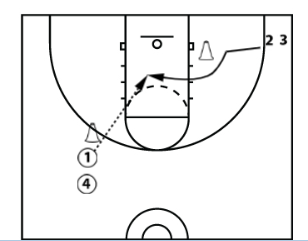
Place a line in the corner and a line with basketballs in the opposite slot.
The first player in the corner line executes a flex cut and receives a pass from the slot line.
Catch and perform the prescribed finish. In this example, two finishes are shown:
- High hands finish
- Rondo finish
Flex Basketball Drill #3 - Contested Finishing Off The Flex Cut
Once players are comfortable with finishing from the corner, you'll want to add defense. Here's another drill from Next Level Finishing Moves With Jim Huber that works on exactly that.

Player 4 cuts off a flex screen from x4.
The coach passes to 4 coming off the screen.
As soon as 4 clears x4, x4 becomes a defender. They turn and try to catch and contest 4's finish.
Flex Offense For Youth Basketball
When working with young players ranging from 5 to 16 years old, we think it's important for you to run an offense that allows players to DEVELOP and improve their skills.
Some offenses are suited extremely well for development and some are not.
Here are some tips to help you improve the skills and development of your players...
1 - Put Players in ALL Offensive Positions
There's a saying that "the center of today is the point guard of tomorrow". To help players maximize their development, it's important for players to get an opportunity to play all positions (inside and outside). Too often, you see big kids stuck in the post and they never leave. These players often struggle at the varsity level because they "stopped growing" and have no skills on the perimeter.
Not to mention, some offenses require guards to post up and some offenses require post players to catch and handle the ball on the perimeter. If you want to develop more VERSATILE players, they need experience in all positions. You never know what offense they will be running in the future.
So for example, in the Flex offense, all players get post up and perimeter opportunities. If you run a motion offense, design your motion offense so all players get opportunities to touch the ball in the post and on the perimeter.
2 - Teach Offensive Concepts like Spacing, Reading Screens, and Ball Reversals
I think it's important for players to learn fundamental offense concepts. They should learn how to set and read screens. They should learn how to set and read ball screens. They should learn how to cut, change speed, and get open. They should learn proper spacing, the importance of player movement, and the importance of ball movement.
When you choose your offense and work with your players, I think it's important to keep these things in mind. By learning these concepts, players will get better and their potential will go way up.
Not all offenses allow you to develop players in these areas. I believe this is a consideration you should make when choosing and constructing your offense.
3 - Allow Players to "Play"
Giving players opportunities to read screens, read situations, and make decisions is incredible for their development!
I think a very structured and rigid offense can be counterproductive for young players. You might win a few games now. But the long term development of these players will be slowed and their potential will be limited.
No matter what offense you choose or run, I think those are three important considerations for all coaches. Even varsity high school coaches need to be developing their sophomores and juniors so they can reach their potential as seniors.
So what should you do?
We would recommend to run the motion offense or the flex offense. Can you run other offenses? Absolutely, but we know that these two offenses will definitely work.
With our teams, we like to run the motion offense because we feel that it develops the best basketball players in regards to skill development and basketball intelligence regarding offensive concepts. We prefer to implement the concepts and strategies explained in the How to Develop a High Scoring Motion Offense.
But if you prefer a little more structure, you could also use the flex offense. Just make sure to teach the motion principles and counters, so the players don't just run a pattern and turn into robots. Don Kelbick does a great job of teaching motion principles with the Flex Offense in his Hybrid Flex Offense DVD.
For all your flex needs, be sure to check out The Hybrid Flex Offense With Don Kelbick.
To get FREE 33 Winning Basketball Plays, click the banner below
What do you think? Let us know by leaving your comments, suggestions, and questions...
|
||||||||||||||||||




 Facebook (145k Followers)
Facebook (145k Followers) YouTube (152k Subscribers)
YouTube (152k Subscribers) Twitter (33k Followers)
Twitter (33k Followers) Q&A Forum
Q&A Forum Podcasts
Podcasts